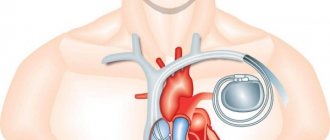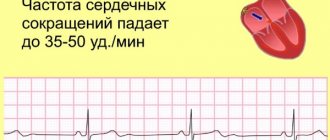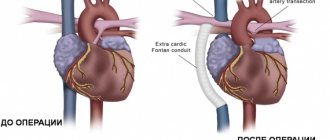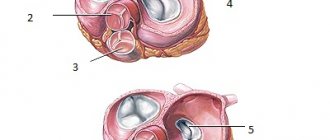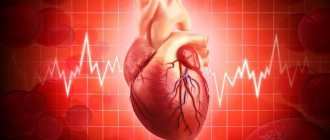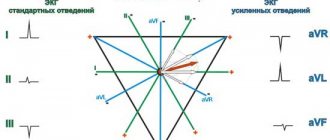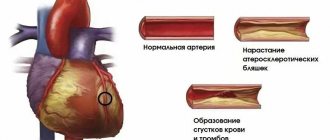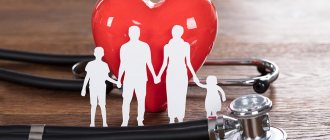Make an appointment by phone: +7 (343) 355-56-57
+7
- About the disease
- Cost of services
- Sign up
- About the disease
- Prices
- Sign up
Sinus arrhythmia (SA)
is an fluctuation in the rhythm of heart contractions emanating from the sinus node.
There is a conduction system in the human heart. It consists of nerve fibers, works on the principle of electrical wiring, and is responsible for ensuring that electrical impulses arise in the heart and are carried out to all its departments. This system is a kind of “battery”, since it is self-regulating and autonomous. In this self-regulating system there is an oscillation of the “current”. In humans, like in any living creature, fluctuations in the frequency and rhythm of heart contractions are possible.
The human heart is alive. It is impossible to artificially “set” its rhythm forever; this is not a household appliance, not a car.
The initiator of heart contraction is the sinus node. If “current fluctuations” occur at its level, then SA develops. It is not life-threatening, is usually secondary and goes away on its own.
Sinus arrhythmia can occur in anyone. During physical activity, emotions, both positive and negative, during sleep. But these deviations in heart rate are so short-term and insignificant that they are sometimes detected only during daily monitoring of the electrocardiogram; they do not require treatment, since they go away on their own, without symptoms.
Arrhythmia in adolescents
Arrhythmia in adolescence is usually not associated with any pathology, but is a feature of the transition period.
In adolescent children, the most common conditions are:
- Respiratory arrhythmia is a typical teenage arrhythmia. When you inhale, the heart rate increases somewhat, and when you exhale it slows down. Such irregularity of heart rhythm indicates increased excitability of the autonomic nervous system and for a teenager this is the norm, while the appearance of respiratory arrhythmia in an adult is a symptom of the disease.
- Extrasystoles are sudden, extraordinary contractions of the heart. Usually they are not felt by a person, but are detected on an ECG. Extrasystoles in adults are a pathology, and in adolescence they can be a variant of the norm. Such cardiac arrhythmia in adolescents occurs due to increased growth of the heart.
Symptoms of cardiac arrhythmia:
- Weakness, accompanied by dizziness, absent-mindedness, drowsiness and headaches. It appears in cases where special efforts are required to perform some action.
- Rapid heartbeat, which feels like a “thrill,” the heart is pounding or “jumping out of the chest.” May be accompanied by strong pulsation in the neck, temples, fingertips, tinnitus and difficulty breathing.
- Pain in the chest, behind the sternum. It can be aching, stabbing, burning. Accompanied by difficulty breathing, cold sweat, and nausea.
- Dyspnea. Breathing becomes frequent and noisy. If shortness of breath occurs at rest or with slight physical exertion, its nature is pathological. It is cardiovascular diseases that lead to insufficient blood circulation. The organs do not receive the required amount of oxygen and accumulate carbon dioxide. Internal organs do not receive the required amount of oxygen. This causes shortness of breath.
Causes of arrhythmia in adolescents and children
In young children, the cause of arrhythmia may be perinatal pathology (disturbances during pregnancy and childbirth), which can lead to a disorder of the neurovegetative regulation of cardiac activity with a change in the relationship between the parasympathetic and sympathetic parts of the nervous system. As a result, electrical instability of the conduction system and heart muscle occurs.
Children's cardiac arrhythmia can be caused by many reasons, but they can be grouped into 3 groups:
1. Extracardiac (associated with other, non-cardiac diseases).
Cardiac arrhythmia in children often has extracardiac origin. In this case, an abnormal heart rhythm in a child may be the result of damage to the nervous system (trauma, infection
, tumors, malformations, etc.), leading to a disorder of the innervation of the heart and immaturity of the conduction system.
2. Cardiac (related to the pathology of the heart itself).
Cardiac causes are not the leading ones in children and adolescents, but when arrhythmia is detected they are excluded first. These could be heart defects, infectious diseases, heart tumors, hereditary syndromes, etc.
3. Mixed.
Diagnosis of arrhythmia
To make an accurate diagnosis, consultation with a pediatric arrhythmologist or pediatric cardiologist is necessary. The initial examination by a specialist includes:
- Studying the medical history.
- Carrying out a full examination (palpation, percussion, auscultation).
If an arrhythmia is suspected, the doctor will refer the child for instrumental diagnostics:
- Electrocardiography
is a universal method that allows you to evaluate the work of the heart in a specific time period. - Daily Holter monitoring.
A more accurate method compared to conventional electrocardiography, as it records the work of the heart over a long period of time (days), including sleep, physical activity, various periods of activity, etc. - Load tests.
This is an analysis of cardiac activity during physical activity of varying intensity.
This method can only be used with older children. After making a diagnosis, an arrhythmologist or pediatric cardiologist may prescribe examinations aimed at identifying the causes of the disease:
- EchoCG
(echocardiography or ultrasound of the heart). Allows you to identify organic causes of the disease, for example, heart defects, tumors, etc. - Radiography.
This method is aimed at identifying extracardiac causes of arrhythmia, for example, pathology of the spine, large vessels. - EEG.
Electroencephalography is indicated in cases of suspected connection of arrhythmia with brain diseases.
The SM-Doctor clinic for children and adolescents is equipped with only modern diagnostic equipment, which allows our specialists to make an accurate diagnosis and prescribe timely treatment for the disease.
Signs and symptoms of arrhythmia in children and adolescents
The main manifestations of arrhythmias in infancy:
- periodic blue or pale skin;
- dyspnea;
- periodic causeless restlessness of the baby;
- sluggish breast or bottle sucking, refusal to eat, little weight gain;
- frequent awakenings, poor sleep, cry
at night.
In an older child, arrhythmia may manifest itself as follows:
- exercise intolerance;
- fainting;
- feeling of heart failure;
- increased fatigue.
Sinus arrhythmia
The human heart must continuously beat in the correct rhythm so that all organs receive a sufficient amount of blood. Even minor malfunctions in the functioning of the cardiac muscle pump can provoke severe disruptions in vital activity. Sinus arrhythmia is a common functional disorder of the cardiovascular system. The disease is diagnosed in patients of any age.
What is sinus arrhythmia?
The term arrhythmia combines a wide range of functional pathologies of the heart that affect the functioning of the myocardium. Doctors classify rhythm disturbances according to the place of occurrence and the nature of the course. Thus, pronounced sinus arrhythmia occurs when the main conduction node of the myocardium is damaged or disrupted. This form of the disease is considered the most benign.
To better understand the nature of the rhythm disorder, it is necessary to have an understanding of the work of the heart. The muscular layer (myocardium) is the main part of the organ responsible for the redistribution of blood in the body. It is thanks to the myocardium that each cell receives a sufficient amount of oxygen and nutrients on time. The strict rhythm of heart activity, including a contraction phase (systole) and a rest phase (diastole), allows the chambers of the atria and ventricles to fill with blood before a new heartbeat. The rhythm of contractions is regulated by the conductive components of the myocardium - the sinus node, atrioventricular node, His bundle and smaller fibers.
The sinus node occupies a dominant position in the regulation of myocardial function. It is here that electrical impulses are generated, stimulating the contraction of muscle fibers and the release of blood into the vessels. Secondary conducting nodes and fibers are responsible for the gradual spread of the impulse throughout all parts of the myocardium. In this case, the main node generates impulses with a certain frequency - from 60 to 100 beats per minute, which determines the mode of operation of the heart at rest. Sinus arrhythmia is characterized by disruption of the main node of the myocardium.
8
24/7
Main types of pathology:
- Sinus tachycardia is the occurrence of too rapid heartbeats (more than 100 beats per minute). The danger is that this mode of myocardial operation does not allow the parts of the heart to fill with blood before contractions, resulting in hemodynamic disorders.
- Sinus bradycardia is a pathological decrease in the frequency of contractions (less than 60 beats per minute). In this case, the organs do not receive sufficient blood supply.
It should be noted that sinus arrhythmia affects only the frequency of myocardial contractions, while the sequence of operation of the organ does not change. Tachycardia and bradycardia can also occur when cardiac functions are preserved, when the body requires adaptation to certain conditions. Active muscle work requires increased blood supply, and during sleep the need for this mode of heart contraction decreases. The pathological form of rhythm change is characterized by a lack of adaptation.
Causes
The etiology of the sinus form of rhythm disorder is almost no different from the causes of any arrhythmia. The disease may be a consequence of other pathologies of the heart and blood vessels that affect the functioning of the sinus node.
Possible reasons:
- Damage to the muscular lining of the heart due to myocardial infarction, injury or infection.
- Cardiac ischemia.
- Inflammatory pathologies of the myocardium.
- Valve malfunction.
- Blood loss.
- Low or high blood pressure.
- Side effects of drugs that affect the heart.
- Respiratory failure.
- Pathology of the thyroid gland.
- Anemia.
- Abuse of caffeine and alcoholic beverages.
- Disruption of the sympathoadrenal system.
Doctors are not always able to determine the exact cause of the disease. In children and adolescents, sinus arrhythmia can occur without any clinical prerequisites, however, at this age, rare attacks of arrhythmia are not considered dangerous. The most severe forms of pathology occur against the background of organic damage to the myocardium.
Symptoms
Signs of rhythm disturbance may vary depending on the frequency of attacks and the etiology of the disease. In most patients, sinus arrhythmia is asymptomatic. In severe cases of the disease, signs may appear indicating a violation of the blood supply to organs.
Symptoms and signs:
- Pain and discomfort in the heart area.
- Increased sweating.
- Breathing disorders, shortness of breath.
- Sensation of pulsation in temples.
- Dizziness and nausea.
- Loss of consciousness.
- Anxiety and fear.
It should be taken into account that other chronic heart diseases, against the background of which arrhythmia occurs, can aggravate the course of arrhythmia. Heart failure and coronary artery disease will significantly increase neurological symptoms.
8
24/7
Diagnostic methods
Sinus node arrhythmia often requires the use of more thorough diagnostic methods, since attacks can occur relatively rarely. You can only detect changes in your heart rate manually or using an electronic device. However, this is not enough to make a diagnosis, so you need to contact a cardiologist. During the appointment, the doctor will review the patient's medical history, conduct a physical examination, and interview the patient to identify complaints. An important task is to exclude the psychogenic form of rhythm disturbance.
Basic methods of instrumental diagnostics:
- Electrocardiography is the recording of the electrical activity of the heart. Special electrodes connected to a cardiogram recording device are placed on the patient's body. Based on the results of this method, one can judge any dysfunction of the organ, characterized by slow impulse conduction and inconsistent contractions.
- Echocardiography is a visual study of the heart using ultrasound. During the examination, the doctor can observe the functioning of the organ on the screen. EchoCG is an excellent way to basicly diagnose arrhythmia and assess the severity of the condition.
- Long-term recording of a cardiogram using a portable device. The patient is instructed to keep a diary of how he feels so that the cardiogram can be studied during an attack. This is the best way to diagnose a latent form of arrhythmia.
- Stress test - obtaining a cardiogram during palpitations. Thus, attacks of the disease can sometimes occur only under conditions of high stress on the cardiovascular system.
- Angiography with contrast is a scan of the blood vessels of the heart to detect blockages, narrowing and other causes of coronary artery disease or heart attack.
- MRI and CT scans provide highly accurate images of the heart.
- Blood analysis. The cardiologist will primarily be interested in parameters such as electrolyte balance, thyroid hormone concentrations, and the presence of enzymes indicating a recent myocardial infarction.
Comprehensive diagnostics should include functional cardiac testing and imaging. Even if a rhythm disorder is detected by one test, other tests may be needed to find the cause of the disorder.
Drug treatment and prevention
Sinus arrhythmia does not always require treatment. First, the doctor must make sure that the change in rhythm is actually provoked by functional or structural pathologies of the cardiovascular or nervous system. If attacks occur against the background of neuroses, thyroid diseases, lack of electrolytes and other secondary causes, appropriate treatment of the primary condition will be required.
If necessary, a drug treatment regimen is prescribed aimed at preventing the development of attacks and preventing complications. As a rule, doctors prescribe the following drugs:
- Direct antiarrhythmic drugs as symptomatic treatment.
- Indirect antiarrhythmic drugs, including cardiac glycosides and beta blockers.
- Blood thinners for stroke prevention.
It must be taken into account that sinus arrhythmia, the treatment of which can be lengthy and ineffective, is highly preventable. Methods to prevent illness include:
- Eliminating fatty foods, alcohol and coffee from the diet.
- Increase physical activity.
- To give up smoking.
- Reducing body weight.
- Coping with stress and anxiety.
- Timely treatment of primary cardiovascular, neurological and metabolic diseases.
- Screening diagnostics of the heart and blood vessels to identify asymptomatic pathologies.
These same methods can be useful if the disease has already been diagnosed.
Surgical interventions
Treatment of sinus arrhythmia may include surgical methods in case of severe disease. As a rule, this is a rhythm disorder due to primary heart pathologies and the ineffectiveness of drug treatment.
Possible surgery options:
- Radiofrequency ablation is the removal of a problem area in the heart using an electrical current.
- Open surgery on the heart and blood vessels to correct structural pathologies.
- Implantation of a pacemaker or defibrillator.
As a rule, surgical treatments are more reliable.
Thus, a rhythm disorder associated with malfunction of the sinus node in most cases has a benign course. However, if unpleasant symptoms appear, you should not delay contacting a doctor.
8
24/7
Types of arrhythmia in children and adolescents
1. Arrhythmias due to impulse formation disorder:
- sinus bradycardia is a decrease in heart rate compared to normal age-related rates;
- sinus arrhythmia
– may be associated with breathing (respiratory) or not;
- sinus tachycardia is an increase in heart rate that exceeds age norms;
| Child's age | Normal heart rate, beats/min. |
| Newborns | 110–170 |
| Up to a year | 102–162 |
| 1–2 years | 94–154 |
| 3–4 years | 90–140 |
| 5–6 years | 86–126 |
| 7–8 years | 78–126 |
| 9–10 years | 68–108 |
| 11–12 years old | 60–100 |
| 13–15 years old | 55–95 |
- pacemaker migration – change in the source of impulse formation;
- extrasystole - premature contraction of the heart, can be supraventricular or ventricular;
- paroxysmal and non-paroxysmal (constant) tachycardia: supraventricular and ventricular;
- atrial flutter is a significantly accelerated, but correct, regular contraction of the atria with a frequency of 250–300 per minute;
- atrial fibrillation – atrial contraction 400–700 per minute;
- ventricular flutter - their contraction with a frequency of 250–300 per minute;
- ventricular fibrillation (fibrillation) – chaotic rhythm (frequency – up to 400 or more per minute).
2. Arrhythmias provoked by impaired impulse conduction:
- Atrioventricular (AV) blocks;
- Intraatrial blocks;
- Intraventricular blocks;
- Sinoatrial (SA) block;
3. Combined arrhythmias:
- Atrioventricular dissociation;
- Sick sinus syndrome;
- Ventricular preexcitation syndrome.
Diagnosis of heart rhythm disorders in children
Cardiac arrhythmia in a child and its nature will be determined using an ECG examination, which is carried out not only if cardiac pathology is suspected or if there are “heart” complaints, but also for other childhood diseases.
ECG can successfully detect pathological arrhythmias (complete AV block, atrial fibrillation
) or arrhythmias that are a variant of the norm for children (incomplete block of the right bundle branch - RBBB, sinus respiratory arrhythmia in children).
However, to make a correct diagnosis and find out the causes of arrhythmia, a comprehensive examination is necessary:
- Studying the child’s medical history, morbidity in the family;
- Electrocardiography;
- X-ray examination of the chest organs;
- Holter monitoring – long-term ECG recording;
- Stress tests (treadmill test);
- Drug electrocardiographic tests;
- Neurophysiological studies (EEG), rheoencephalography;
- Echocardiographic examination (ECHO-CG).
Types of arrhythmia:
Atrial fibrillation.
An abnormal heart rhythm during which the atria contract faster than the ventricles. This is a complication due to coronary heart disease. Diseases of the endocrine system can also cause the development of atrial fibrillation. Unlike normal heartbeat, muscle fibers in atrial fibrillation are excited frequently and chaotically. In addition to frequent contractions of the heart muscle, the disease is accompanied by increased sweating, darkening of the eyes, muscle weakness and fainting.
Sinus arrhythmia.
During the disease, the sinus node, the main “engine” of impulses in the heart, is damaged. Because of this, the sinus node begins to malfunction. With sinus arrhythmia, an alternation of rapid and slow rhythm occurs. A common type of sinus arrhythmia occurs, in which during inhalation the heart rate increases, and when exhaling, on the contrary, it decreases. This disease is also called respiratory arrhythmia. The pathology is accompanied by dizziness, severe fatigue, breathing problems, and loss of consciousness.
Atrial flutter.
This is a rapid atrial rhythm, reaching 200-400 beats per minute. The reasons for the deviation may be complications after other cardiovascular diseases, the postoperative period, severe stress, or pathological processes in the body. Accompanied by symptoms such as general weakness, discomfort in the chest or behind the sternum, shortness of breath and sudden attacks of rapid heartbeat.
Treatment of heart rhythm disorders in children and adolescents
Treatment of arrhythmia in children is prescribed individually depending on its cause, duration, as well as the effect on the child’s well-being and the state of his hemodynamics.
Treatment of arrhythmia in adolescents and children is always complex and includes vascular, neurometabolic
drugs,
antioxidants
and cell membrane stabilizers.
In some situations, it is necessary to use specialized antiarrhythmic drugs ( amiodarone
, procainamide, verapamil, etc.). For example, with a malignant course of arrhythmia, arrhythmogenic dysfunction of the left ventricle.
Determination of indications for pharmacotherapy and selection of medications is carried out in a hospital setting by a cardiologist.
Sick children with persistent, life-threatening, prognostically unfavorable rhythm disorders are indicated for surgical treatment.
Treatment of arrhythmia
Treatment methods for arrhythmia in children depend on the causes and variant of the identified disorders.
Only an arrhythmologist (pediatric cardiologist) makes a decision on the need to treat arrhythmia. Self-treatment of the disease is strictly prohibited. This threatens the child with complications and the development of dangerous symptoms. However, given the often asymptomatic nature of many rhythm disturbances, including life-threatening ones, parents themselves should pay great attention to the problem.
To make an appointment with children's ari, fill out the online form or call us at +7 (495) 292-59-86.
Causes of arrhythmia
The heart has the property of automaticity. It contracts under the influence of impulses that are generated in the heart itself. The myocardial conduction system, formed by nodes of nervous tissue, is responsible for the generation and conduction of impulses. Disturbances in the functioning of this system lead to abnormal heart rhythm.
Cardiovascular diseases can cause arrhythmia:
- coronary heart disease (poor circulation of the heart muscle);
- previous myocardial infarction. In 15% of cases, a complication such as post-infarction aneurysm is observed - protrusion of the wall of the heart ventricle. The aneurysmal segment does not participate in contraction, which leads to arrhythmia;
- cardiomyopathies (changes in the size and shape of the heart), as well as congenital and acquired heart defects;
- myocarditis (inflammatory diseases of the heart muscle);
- arterial hypertension.
In addition, arrhythmia can be caused by:
- vegetative-vascular dystonia;
- disturbance of the electrolyte balance of the body (as a result of acute lack of magnesium, as well as deficiency or excess of potassium and calcium);
- smoking, alcohol abuse, poisoning;
- stress;
- physical activity;
- febrile conditions in infectious diseases;
- endocrine disorders. In particular, arrhythmia can be observed during menopause.
